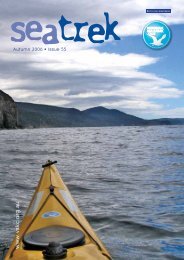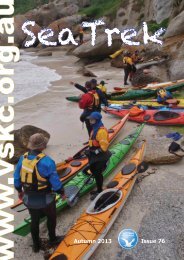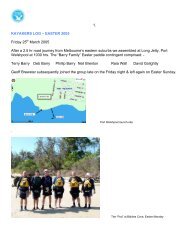Sea Trek Issue 70 - Victorian Sea Kayak Club
Sea Trek Issue 70 - Victorian Sea Kayak Club
Sea Trek Issue 70 - Victorian Sea Kayak Club
You also want an ePaper? Increase the reach of your titles
YUMPU automatically turns print PDFs into web optimized ePapers that Google loves.
The cap is now ready for the shock cord<br />
to be threaded through. Don’t do this<br />
until you have the Magnetx switch into<br />
place.<br />
STEP 5<br />
Remove the rubber liner out of the pelican<br />
box. Drill a 12mm and a 16mm hole<br />
in the end of the box. You may need to<br />
file the lock ring down to allow the<br />
glands to fit. Once glands fit, cut the rubber<br />
liner around the gland lock ring so the<br />
liner can sit back the box.<br />
Cut 2 pieces of 50 mm Velcro to the right<br />
length of the box. Turn the box upside<br />
down so the bottom is facing up. File all<br />
ridges off and roughen the shiny surface.<br />
This increases the surface area for the<br />
Sikaflex to stick to. Glue the Velcro to<br />
the box and allow to dry.<br />
Decide where the Battery box best fits<br />
into your day hatch and glue 2 pieces of<br />
Velcro of the opposite sex into your day<br />
hatch. I find behind the seat is best but<br />
this can also depend where your pump<br />
may end up. Some kayaks have the pump<br />
in the foot well and the Battery box end<br />
up in the front hatch.<br />
Place the wires from the pump through<br />
the small gland and the Magnetx switch<br />
in through the 16mm glands. Crimp 2<br />
spade lugs on the battery leads and join<br />
the pump leads with a crimp joiner. Heat<br />
shrink joint or use self-amalgamating<br />
tape.<br />
STEP 6<br />
Decide where the Magnetx switch is best<br />
suited for your use and make sure you can<br />
mount the Magnet in the cap somewhere<br />
that shock cord can be placed between to<br />
existing tie down point or even use existing<br />
deck rigging. This is really up to you.<br />
Once you have decided turn the boat<br />
upside down and glue the Magnetx switch<br />
box to the underside of the deck. If you<br />
have a plastic boat use Selley’s All Clear<br />
or if fibreglass kayak, use Sikaflex.<br />
Good Luck!<br />
Neil Brenton<br />
PIMP MY BOAT :<br />
SEAT BACK REST CUSTOMISING<br />
by Andrew Hurnard<br />
I’ve never been a fan of back bands: they<br />
rub, they pinch and they never seem to be<br />
in quite the right place, but I didn’t think<br />
there was an alternative.<br />
There is. I found photos of foam block<br />
backrest on the internet - in fact I found a<br />
few, but no real description or guidelines<br />
on how to make one and shape it to fit<br />
you. So off to my friendly local chiropractor<br />
I went with a prototype under my<br />
arm.<br />
He showed me that the key to a wellfitting<br />
supportive back rest is your sacrum.<br />
Where or what is that I hear you<br />
ask? Well – stand up, run your hands<br />
down the skin of the middle of your lower<br />
back. Just before your bum starts, you<br />
will find two bumps, one on each side of<br />
your spine. These are the bones of your<br />
pelvis - these and the bit between them,<br />
forms your sacrum.<br />
A lot of kayak back bands claim to provide<br />
lumbar support (the bit above your<br />
sacrum where your spine curves in). The<br />
problem with lumbar support is that it<br />
provides the wrong sort of support (yep –<br />
this is true of your office chair too) because<br />
you don’t need to maintain an upright<br />
position or engage any muscles. The<br />
lumbar support is doing it all for you.<br />
Sacral support<br />
on the other<br />
hand promotes<br />
good upright<br />
posture and<br />
encourages you<br />
to engage your<br />
core muscles.<br />
On top of that,<br />
torso rotation<br />
when paddling is<br />
not encumbered,<br />
and it won’t get<br />
in the way when<br />
getting in or out<br />
of the kayak.<br />
My backrest<br />
goes straight up<br />
until the top of<br />
my sacrum then<br />
curves gently<br />
back to the cockpit combing. This is right<br />
for me but you may prefer the base to<br />
angle out slightly to support a more aggressive<br />
padding style or for the support<br />
to come higher up your back. Cut the<br />
backrest larger than you need to so you<br />
can trim it down over time to the shape<br />
that best suits you. I used the same foam<br />
as the Nadgee seat but you can use anything<br />
really that does not compress very<br />
much.<br />
Handy Hints:<br />
· Get a friend to measure the distance<br />
between the two bumps of your pelvis<br />
and allow for at least an extra cm<br />
or more overall. It is vital that both<br />
these bumps are fully supported by<br />
the backrest. For example I use a 16<br />
cm wide backrest and my “bumps”<br />
are about 14cm apart.<br />
· The backrest should butt up against<br />
the bulkhead behind your seat. Like<br />
foot peg/brace bars, back rests take a<br />
lot of force when you’re paddling, so<br />
you want it solid.<br />
· When working out the correct shape<br />
for your backrest, use a cardboard<br />
template. The<br />
shape can get<br />
surprisingly complicatedespecially<br />
if the bulkhead<br />
is angled. Cardboard<br />
is cheaper<br />
than foam...<br />
· Carry sandpaper<br />
or a Stanley<br />
shureform with<br />
you when you’re<br />
doing test runs<br />
and paddle<br />
somewhere you<br />
can pull up on the<br />
beach to make<br />
alterations as you<br />
go.<br />
· Down the middle of the face of the<br />
backrest that supports you, cut an approximately<br />
2 cm wide 5 mm deep<br />
slot. This is so the backrest doesn’t<br />
push directly on your spinal column.<br />
21













